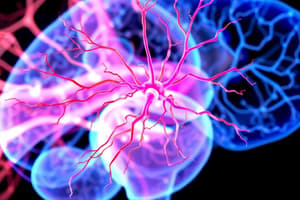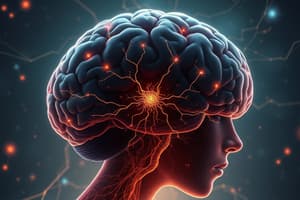Podcast
Questions and Answers
Match the following Spinocerebellar Ataxia types with their characteristics:
Match the following Spinocerebellar Ataxia types with their characteristics:
SCA1 = CAG repeat expansion causing ataxia and dysarthria SCA2 = Ataxia, tremors, and eye movement abnormalities SCA3 = Most common form with dystonia and dysarthria SCA7 = Retinal degeneration associated with ataxia
Match the following Parkinson's Disease motor symptoms with their descriptions:
Match the following Parkinson's Disease motor symptoms with their descriptions:
Tremor = Resting tremor usually starting in one hand Bradykinesia = Slowness of movement impacting daily activities Rigidity = Muscle stiffness affecting limb movement Postural Instability = Difficulty maintaining balance and coordination
Match the following types of Spinal Muscular Atrophy with their onset characteristics:
Match the following types of Spinal Muscular Atrophy with their onset characteristics:
SMA Type 1 = Onset before 6 months, severe SMA Type 2 = Onset between 6-18 months, can sit but not stand SMA Type 3 = Onset after 18 months, patients can walk SMA Type 4 = Adult-onset with milder symptoms
Match the following ALS pathophysiology mechanisms with their impacts:
Match the following ALS pathophysiology mechanisms with their impacts:
Match the following non-motor symptoms of Parkinson's Disease with their descriptions:
Match the following non-motor symptoms of Parkinson's Disease with their descriptions:
Match the following Spinocerebellar Ataxia types with their symptomatology:
Match the following Spinocerebellar Ataxia types with their symptomatology:
Match the following types of Spinal Muscular Atrophy with their clinical features:
Match the following types of Spinal Muscular Atrophy with their clinical features:
Match the following ALS clinical features with their effects:
Match the following ALS clinical features with their effects:
Which of the following symptoms is NOT associated with Spinocerebellar Ataxia Type 3 (SCA3)?
Which of the following symptoms is NOT associated with Spinocerebellar Ataxia Type 3 (SCA3)?
SMA Type 4 is the most severe form of Spinal Muscular Atrophy.
SMA Type 4 is the most severe form of Spinal Muscular Atrophy.
What is the primary cause of motor neuron degeneration in ALS?
What is the primary cause of motor neuron degeneration in ALS?
The presence of excess _______ in ALS leads to excitotoxicity.
The presence of excess _______ in ALS leads to excitotoxicity.
Match the type of Spinal Muscular Atrophy with its corresponding onset age:
Match the type of Spinal Muscular Atrophy with its corresponding onset age:
What type of mutation is primarily associated with Spinocerebellar Ataxia Type 1 (SCA1)?
What type of mutation is primarily associated with Spinocerebellar Ataxia Type 1 (SCA1)?
Tremors are a key motor symptom of Parkinson's Disease.
Tremors are a key motor symptom of Parkinson's Disease.
Name one consequence of glutamate toxicity in ALS.
Name one consequence of glutamate toxicity in ALS.
Study Notes
Spinocerebellar Ataxia Types
- Definition: A group of hereditary disorders characterized by progressive degeneration of the cerebellum and its connections.
- Types:
- SCA1: Caused by CAG repeat expansion; symptoms include ataxia and dysarthria.
- SCA2: Presents with ataxia, tremors, and eye movement abnormalities; also due to CAG repeats.
- SCA3 (Machado-Joseph Disease): Most common form; symptoms include ataxia, dystonia, and dysarthria.
- SCA6: Characterized by gait and limb ataxia, with less severe cognitive impairment.
- SCA7: Associated with retinal degeneration and ataxia due to CAG repeats.
Parkinson's Disease Symptoms
- Motor Symptoms:
- Tremor: Resting tremor usually starting in one hand.
- Bradykinesia: Slowness of movement, impacting daily activities.
- Rigidity: Muscle stiffness affecting limb movement.
- Postural Instability: Difficulty maintaining balance and coordination.
- Non-Motor Symptoms:
- Sleep Disturbances: Insomnia, REM sleep behavior disorder.
- Cognitive Changes: Memory issues, executive dysfunction.
- Mood Disorders: Depression and anxiety are common.
- Autonomic Dysfunction: Changes in blood pressure, sweating, and bowel habits.
Spinal Muscular Atrophy Types
- Definition: A genetic disorder characterized by the loss of motor neurons leading to muscle weakness and atrophy.
- Types:
- SMA Type 1: Most severe; onset before 6 months; infants rarely achieve independent sitting.
- SMA Type 2: Onset between 6-18 months; can sit but cannot stand or walk independently.
- SMA Type 3: Onset after 18 months; patients can walk but may lose this ability over time.
- SMA Type 4: Adult-onset; milder symptoms with gradual progression.
ALS Pathophysiology
- Definition: Amyotrophic lateral sclerosis (ALS) is a progressive neurodegenerative disease affecting motor neurons.
- Mechanism:
- Degeneration of Motor Neurons: Both upper (cortex) and lower (spinal cord) motor neurons degenerate, leading to muscle weakness.
- Glutamate Toxicity: Increased levels of glutamate contribute to neuronal death.
- Oxidative Stress: Accumulation of free radicals damages neurons.
- Protein Aggregation: Misfolded proteins (e.g., TDP-43) form aggregates in motor neurons.
- Clinical Features: Muscle weakness, atrophy, spasticity, dysphagia, and respiratory failure.
Spinocerebellar Ataxia Types
- Group of hereditary disorders leading to progressive degeneration of the cerebellum and its connections.
- SCA1: Caused by CAG repeat expansion; symptoms include ataxia and dysarthria.
- SCA2: Features ataxia, tremors, and eye movement abnormalities; also linked to CAG repeats.
- SCA3 (Machado-Joseph Disease): Most prevalent form; presents with ataxia, dystonia, and dysarthria.
- SCA6: Characterized by gait and limb ataxia with less severe cognitive impairment than other types.
- SCA7: Involves retinal degeneration; symptoms include ataxia due to CAG repeats.
Parkinson's Disease Symptoms
- Motor Symptoms:
- Tremor: Typically starts as a resting tremor in one hand.
- Bradykinesia: Marked slowness of movement affecting daily tasks.
- Rigidity: Muscle stiffness influencing limb movement.
- Postural Instability: Challenges in maintaining balance and coordination.
- Non-Motor Symptoms:
- Sleep Disturbances: Includes insomnia and REM sleep behavior disorder.
- Cognitive Changes: Memory problems and executive dysfunction noted.
- Mood Disorders: High prevalence of depression and anxiety.
- Autonomic Dysfunction: Alterations in blood pressure, sweating, and bowel habits.
Spinal Muscular Atrophy Types
- Genetic condition causing loss of motor neurons, resulting in muscle weakness and atrophy.
- SMA Type 1: Most severe form; onset occurs before 6 months; infants seldom achieve independent sitting.
- SMA Type 2: Begins between 6-18 months; patients can sit but cannot stand or walk independently.
- SMA Type 3: Onset after 18 months; patients can walk but may progressively lose this ability.
- SMA Type 4: Adult-onset; features milder symptoms with a gradual progression over time.
ALS Pathophysiology
- Amyotrophic lateral sclerosis (ALS) is a severe progressive neurodegenerative disorder affecting motor neurons.
- Mechanism:
- Degeneration of Motor Neurons: Involves both upper (cortex) and lower (spinal cord) motor neuron degeneration, leading to muscle weakness.
- Glutamate Toxicity: Elevated glutamate levels contribute to neuronal cell death.
- Oxidative Stress: Accumulation of free radicals that damage neural structures.
- Protein Aggregation: Formation of aggregates from misfolded proteins such as TDP-43 within motor neurons.
- Clinical Features: Includes muscle weakness, atrophy, spasticity, dysphagia, and ultimately respiratory failure.
Spinocerebellar Ataxia Types
- Inherited disorders that cause progressive degeneration of the cerebellum and its connections.
- SCA1: Involves CAG repeat expansion in the ATXN1 gene; presents with ataxia and dysarthria.
- SCA2: Caused by CAG repeats in the ATXN2 gene; symptoms include ataxia, dysarthria, and peripheral neuropathy.
- SCA3 (Machado-Joseph Disease): Results from CAG repeat expansion in the ATXN3 gene; symptoms include ataxia, dystonia, and cognitive decline.
- SCA6: Linked to mutations in the CACNA1A gene; characterized by ataxia and balance issues.
- SCA7: Caused by CAG repeat expansions in the ATXN7 gene; includes symptoms of ataxia and retinal degeneration.
Spinal Muscular Atrophy Types
- Genetic disorder impacting motor neurons in the spinal cord, leading to muscle weakness and atrophy.
- SMA Type 1 (Werdnig-Hoffmann Disease): Most severe form; manifests before 6 months; symptoms include inability to sit unassisted and respiratory failure.
- SMA Type 2: Onset between 6-18 months; patients can sit but may not walk independently; slower progression than Type 1.
- SMA Type 3 (Kugelberg-Welander Disease): Onset after 18 months; individuals can walk but may gradually lose this ability.
- SMA Type 4: Late-onset, beginning in adulthood; symptoms are milder and include progressive muscle weakness.
ALS Pathophysiology
- Amyotrophic Lateral Sclerosis (ALS) is characterized by progressive degeneration of motor neurons.
- Motor Neuron Degeneration: Impacts both upper motor neurons in the cortex and lower motor neurons in the spinal cord, resulting in muscle weakness and atrophy.
- Glutamate Toxicity: Excessive glutamate causes excitotoxicity, leading to neuronal death.
- Oxidative Stress: An imbalance between free radicals and antioxidants results in neuronal damage.
- Protein Aggregation: Abnormal deposits (like TDP-43) disrupt neuron function and homeostasis.
Parkinson's Disease Symptoms
- Progressive neurodegenerative disorder primarily affecting movement.
- Motor Symptoms:
- Tremor: Often a resting tremor, particularly visible in the hands.
- Bradykinesia: Characterized by slowness of movement.
- Rigidity: Muscle stiffness in limbs and trunk.
- Postural Instability: Compromised balance and coordination.
- Non-Motor Symptoms:
- Cognitive Impairment: Includes memory issues and difficulties with executive function.
- Mood Disorders: Depression and anxiety frequently observed.
- Sleep Disturbances: Common issues include insomnia and REM sleep behavior disorder.
- Autonomic Dysfunction: Problems with regulating blood pressure and perspiration.
Studying That Suits You
Use AI to generate personalized quizzes and flashcards to suit your learning preferences.
Description
Test your knowledge on Spinocerebellar Ataxia types and Parkinson's Disease symptoms. This quiz covers hereditary disorders affecting the cerebellum and motor symptoms associated with Parkinson's. Dive into the specifics of each condition and enhance your understanding of these neurological disorders.




